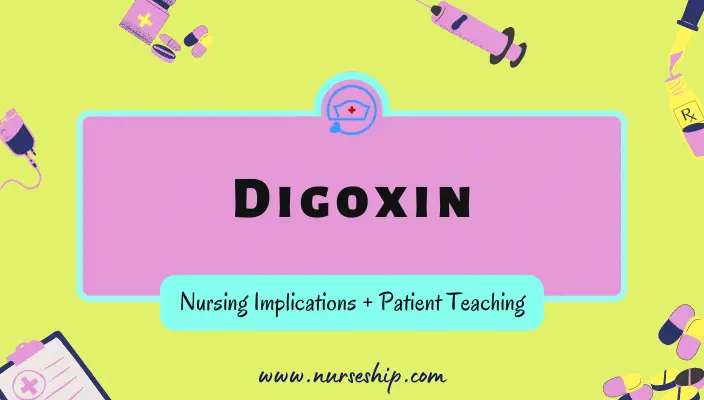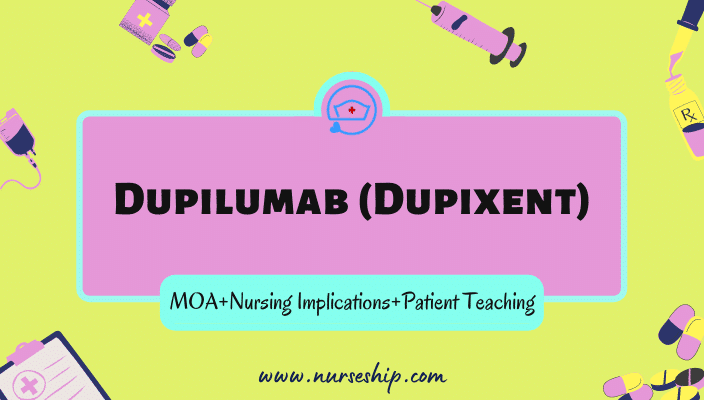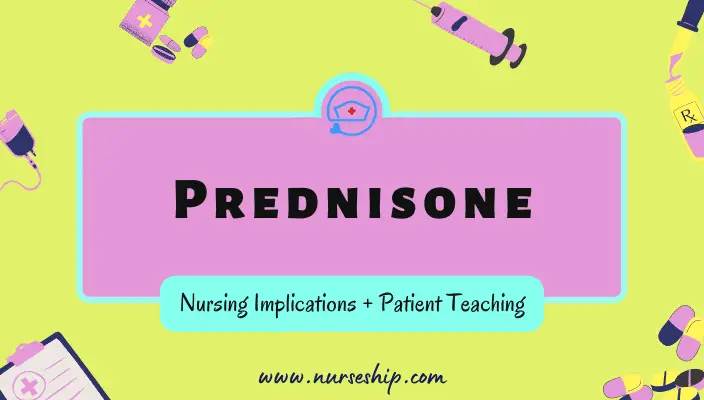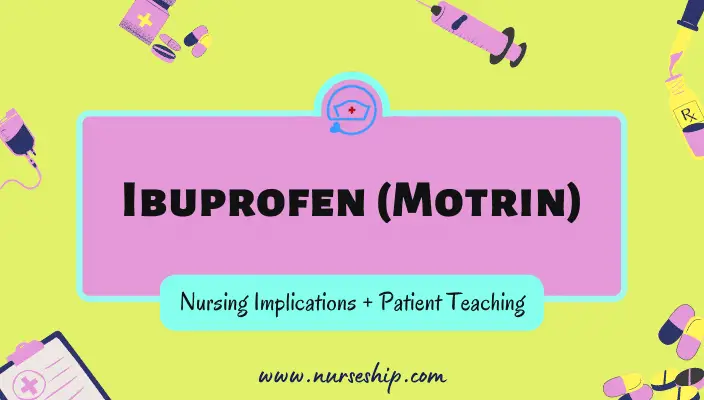Introduction
In this article, you’ll learn about digoxin nursing implications and patient teachings. Also, its dosage, indication, side effects, interactions, and signs and symptoms of digoxin toxicity.
Digoxin belongs to the digitalis glycosides group of drugs. These are some of the oldest drugs used in medicine which date back to 1200AD.
Digitalis inhibits the sodium-potassium pump, leading to an increase in intracellular sodium. This surge causes a calcium influx, which causes the heart muscle fibers to contract more effectively. The main actions of digitalis on the myocardium are:
(1) positive inotropic effect (increases myocardial contraction stroke volume),
(2) negative chronotropic effect (lowers heart rate), and
(3) negative dromotropic effect (lowers heart cell conduction).
Generic Name: Digoxin
Brand Names: Toloxin (CAN), Digitek, Lanoxin, Lanoxin Pediatric.
Digoxin Class and Category
Pharmacologic class: Cardiac glycoside
Therapeutic class: Antiarrhythmic, ionotropic
Pregnancy category: C
Digoxin Dosage
Intravenous (IV) Loading and Maintenance Dose
- Adults and children older than 10yrs: 8 – 12 mcg/kg in three divided doses. First dose should be equal to 50% of the total dose and the subsequent two doses each 25% of initial loading dose, administered every 6-8 hours apart. Give slow IV over 5 minutes. Maintenance Dose: 2.4 – 3.6 mcg/kg OD.
- Children 5 to 10yrs: 15 – 30 mcg/kg in three divided doses. First dose should be equal to 50% of the total dose and the subsequent two doses each 25% of initial loading dose, administered every 6-8 hours apart. Give slow IV over 5 minutes. Maintenance Dose: 2.3 – 4.5 mcg/kg BD.
- Children 2 to 5yrs: 25 – 35 mcg/kg in three divided doses. First dose should be equal to 50% of the total dose and the subsequent two doses each 25% of initial loading dose, administered every 6-8 hours apart. Give slow IV over 5 minutes. Maintenance Dose: 3.8 – 5.3 mcg/kg BD.
- Infants 1 – 24 months: 30 – 50 mcg/kg in three divided doses. First dose should be equal to 50% of the total dose and the subsequent two doses each 25% of initial loading dose, administered every 6-8 hours apart. Give slow IV over 5 minutes. Maintenance Dose: 4.5 – 7.5 mcg/kg BD.
- Full-term neonates: 20 – 30 mcg/kg in three divided doses. First dose should be equal to 50% of the total dose and the subsequent two doses each 25% of initial loading dose, administered every 6-8 hours apart. Give slow IV over 5 minutes. Maintenance Dose: 3 – 4.5 mcg/kg BD.
- Premature neonates: 15 – 25 mcg/kg in three divided doses. First dose should be equal to 50% of the total dose and the subsequent two doses each 25% of initial loading dose, administered every 6-8 hours apart. Give slow IV over 5 minutes. Maintenance Dose: 1.9 – 3.1 mcg/kg BD.
Oral Loading and Maintenance Dose
- Adults and children older than 10yrs: 10 – 15 mcg/kg in three divided doses. First dose should be equal to 50% of the total dose and the subsequent two doses each 25% of initial loading dose, administered every 6-8 hours apart. Maintenance Dose: 3.4 – 5.1 mcg/kg OD.
- Children 5 to 10yrs: 20 – 45 mcg/kg in three divided doses. First dose should be equal to 50% of the total dose and the subsequent two doses each 25% of initial loading dose, administered every 6-8 hours apart. Maintenance Dose: 3.2 – 6.4mcg/kg BD.
- Children 2 to 5yrs: 30 – 45 mcg/kg in three divided doses. First dose should be equal to 50% of the total dose and the subsequent two doses each 25% of initial loading dose, administered every 6-8 hours apart. Maintenance Dose: 7.5 – 10 mcg/kg BD.
- Infants 1 – 24 months: 35 – 60 mcg/kg in three divided doses. First dose should be equal to 50% of the total dose and the subsequent two doses each 25% of initial loading dose administered every 6-8 hours apart. Maintenance Dose: 10 – 15 mcg/kg BD.
- Full-term neonates: 25 – 35mcg/kg in three divided doses. First dose should be equal to 50% of the total dose and the subsequent two doses each 25% of initial loading dose, administered every 6-8 hours apart. Maintenance Dose: 6 – 10 mcg/kg BD.
- Premature neonates: 20 – 30 mcg/kg in three divided doses. First dose should be equal to 50% of the total dose and the subsequent two doses each 25% of initial loading dose, administered every 6-8 hours apart. Maintenance Dose: 5 – 7.5 mcg/kg BD.
Digoxin Pharmacokinetics and Pharmacodynamics
| Route | Onset | Peak | Duration |
| IV | 0.5 – 2hr | 6 – 8hr | 3 – 4days |
| PO | 5 – 30min | 1 – 5hr | 3 – 4days |
Absorption: Digoxin is effectively absorbed from the GI tract when taken orally.
Distribution: Protein bind 30%
Metabolism: Partial Hepatic.
Half-life: 36 – 48 hrs
Excretion: Mostly the kidneys eliminate inactive substances through urine.

Human Anatomy & Physiology Course
- Guidebooks
- Complete Diagrams & Lessons
- Certifications
- Quiz & Answers
- And More…
Digoxin Mechanism of Action
- Inhibits the sodium-potassium ATPase pump, causing calcium influx thereby, promoting cardiac contractility.
- Increases cardiac contraction force and velocity, resulting in positive inotropic effects.
- Digoxin acts as an antiarrhythmic agent by slowing the conduction rate and lengthening the effective refractory period of the AV node.
What are the indications of digoxin?
Digoxin indications include:
- Heart failure (HF)/ CHF
- Atrial flutter
- Atrial fibrillation (afib)
- It is also used off-label for paroxysmal supraventricular tachycardia (PSVT) treatment/prophylaxis
What are the contraindications of digoxin?
The contraindications of digoxin are:
- Ventricular dysrhythmias
- Second-degree or third-degree AV block
Caution: AMI, renal disease, hypothyroidism, hyperthyroidism, hepatic dysfunction, bradycardia, hypokalemia, hypertension, cor pulmonale, Wolff-Parkinson-White syndrome.
Digoxin Interactions
- Increases digoxin serum level with quinidine, flecainide, verapamil
- Lowers digoxin absorption with antacids, colestipol
- Risk for digoxin toxicity increases when taken with thiazide diuretics, loop diuretics, amiodarone, corticosteroids.
Herbal/food interactions
- Licorice may amplify negative effects.
- High fiber and high pectin may reduce absorption.
- Flaxseed and psyllium may decrease the effect of digoxin.
- Foxglove, goldenseal, hawthorn, and rue may increase cardiac effect.
What are digoxin side effects?
Digoxin side effects / adverse reactions include:
- Anorexia
- Nausea
- Vomiting
- Diarrhea
- Abdominal pain
- Headache
- Blurred vision
- Diplopia
- Photophobia
- Drowsiness
- Dizziness
- Fatigue
- Confusion
- Apathy
- Disorientation
- Depression
- Life-threatening adverse reactions: Atrioventricular block, cardiac dysrhythmias
Digoxin Nursing Diagnosis
- Decreased cardiac output related to decreased myocadial contractility.
- Ineffective peripheral tissue perfusion related to decreased myocadial contractility.
- Anxiety related to hospitalization; serious cardiac health status.
Click here to see Afib nursing care plan
Click here to see nursing care plan for congestive heart failure (CHF)
Digoxin Nursing Implications [Nursing Considerations]
Digoxin nursing implications are divided into nursing assessment, interventions, and evaluation.
Nursing assessment
- Take a comprehensive medical, drug, and herbal history. Determine the previous hypersensitivity to digoxin and related ingredients and possible food interactions.
- Obtaining a baseline vital signs for future comparison including apical pulse.
- Assess apical pulse for 1 full minute before administering each dose. If apical pulse is less than 60bpm in adult or less than 90bpm in infant, reassess after 1 hr. Notify the physician if still patient is having bradycardia.
- Closely observe for signs and symptoms of digoxin toxicity. Anorexia, nausea, vomiting, bradycardia, cardiac dysrhythmias, altered mental status, and visual disturbances are all common symptoms. Report symptoms immediately to the physician.
Nursing interventions/ actions
- Monitor the apical pulse rate before administering digoxin. If your pulse rate is less than 60bpm, DO NOT administer.
- Monitor ECG tracing for cardiac dysrhythmias.
- Determine the presence of HF by observing the signs of peripheral and pulmonary edema.
- Maintain intake and output (I&O) chart.
- Monitor serum digoxin level (Normal therapeutic range: 0.8 to 2 ng/mL; Digoxin toxicity level: more than 2 ng/mL).
- Monitor serum potassium levels (normal range: 3.5 to 5.3 mEq/L) and report hypokalemia (less than 3.5 mEq/L). Patients with hypokalemia are more likely to develop digitalis toxicity and severe arrhythmias.
- Digoxin is not advised in patients with acute cor pulmonale with heart failure linked with amyloid heart disease, constrictive pericarditis, heart failure with preserved ejection fraction (HFpEF), or restrictive cardiomyopathy due to the increased vulnerability to digoxin toxicity. Digoxin is also not indicated for patients with idiopathic hypertrophic subaortic stenosis because its inotropic effects may aggravate outflow blockage.
- Digoxin therapy may be ineffective if underlying thiamine deficiency is not treated in patients with beri-beri heart disease.
IV administration considerations
- Administer IV digoxin undiluted or dilute with 1:4 ratio or more with sterile water for injection, NS, or D5W.
- Administer immediately after dilution.
- Administer slowly over 5 minutes.
- Assess ECG tracings for cardiac dysrhythmias.
- Discard the injection if it is discolored or contains precipitate.
Evaluation
Evaluate the effectiveness of digoxin treatment: improvements in symptoms such as decreased heart rate and decreased rales; no signs of side effects or digoxin toxicity; obtained therapeutic serum digoxin levels, stabilization of atrial fibrillation.
Pregnancy/breastfeeding considerations for digoxin
- Digoxin crosses placenta and is present in breast milk.
- Assess the newborn for the signs and symptoms of digoxin toxicity such as dysrhythmias and vomiting.
- Instruct the lactating mother to consult before taking digoxin.
- Digoxin dosage may need to increase during pregnancy and decrease during postpartum. Closely monitor the serum digoxin levels.
What is the patient teaching for digoxin?
- Teach the patient and caretaker how to take pulse accurately.
- Advise the patient to take pulse before each dose and notify healthcare provider if pulse is less than 60 beats/minute or suddenly increases the pulse rate.
- Instruct the patient to take the medicine exactly as prescribed and not to stop abruptly.
- Teach the patient to avoid OTC medicines when taking digoxin.
- Teach the patient about food and herbal interactions.
- Instruct the patient that he/she should always have an identity card including digoxin therapy and diagnosis information with them.
- Teach the patient about signs and symptoms of digoxin toxicity and to report immediately if such symptoms appears. The signs and symptoms of digoxin toxicity include, but are not limited to, nausea, vomiting, diarrhea, visual changes, confusion, and malaise.
- If the missed dose is within 12 hours of the scheduled dose, teach the patient to take it as soon as he/she remembers. If not, advise to notify the prescriber as soon as possible.
- Educate patients to consume potassium-rich foods such as fresh and dried fruits, fruit juices, and vegetables, and potatoes.
Digoxin (Digitalis) Toxicity
Cardiotoxicity is a significant side effect of digoxin that causes ventricular dysrhythmias. Digoxin-induced ventricular dysrhythmias can be caused by three altered heart functions:
(1) AV conduction suppression,
(2) enhanced automaticity, and
(3) shortened refractory period in ventricular muscle.
Signs and Symptoms of Digoxin (Digitalis) Toxicity
- Anorexia
- Diarrhea
- Nausea
- Vomiting
- Bradycardia (pulse rate less than 60 beats/min)
- Pre-mature ventricular contractions
- Headaches
- Malaise
- Blurred vision
- Visual illusions (white, green, yellow halos around objects)
- Confusion
- Delirium
- Ventricular dysrhythmias
What is the antidote for digoxin?
The antidote for digoxin or digitalis toxicity is digoxin immune Fab (ovine, Digibind). This drug binds to digoxin to produce complex molecules that can be eliminated in the urine, preventing digoxin from binding to the cellular site of action.
Treatment for Digoxin Overdose (Digitalis Toxicity)
- Discontinue the medicine
- Monitor ECG
- Administer potassium as prescribed.
- Administer adrenergic-blocking agent as prescribed.
- Administer digoxin immune FAB as prescribed.
- Digoxin-induced ventricular dysrhythmias can be effectively treated with the antidysrhythmic drugs phenytoin and lidocaine. Lidocaine should not be used as long-term treatment.
See Also
Nursing care plan for congestive heart failure (CHF)
Conclusion
You learned about digoxin nursing implications (aka nursing considerations) and patient teaching in this article. In addition, you’ve learned about digoxin’s mechanism of action, pharmacokinetics, dosage, indications, contraindications, side effects, and signs and symptoms of digoxin toxicity.
Recommended Readings & Reference
Kee, J., Hayes, E., & McCuistion, L. (2015). PHARMACOLOGY A Patient-Centered Nursing Process Approach (8th ed.). Elsevier Inc/Saunders.
Kizior, R., & Hodgson, K. (2021). SAUNDERS NURSING DRUG HANDBOOK 2021. Elsevier Inc.
Jones & Bartlett Learning. (2021). Nurse’s Drug Handbook (20th ed.). Jones & Bartlett Learning, LLC.
Skidmore-Roth, L. (2021). MOSBY’S 2021 NURSING DRUG REFERENCE (34th ed.). Elsevier Inc.




